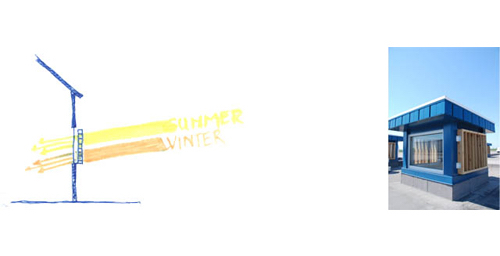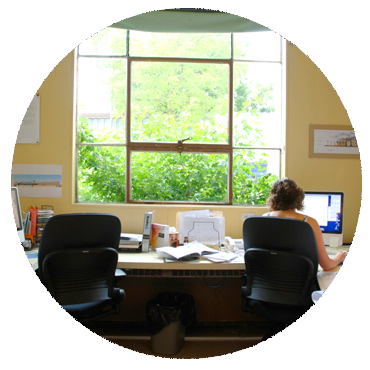Natural daylighting is a strategy we attempt to use in every design we undertake. It is a no-brainer in our eyes to light a space with the sun. Daylighting has many benefits including;
- sunlight
- views to the exterior
- electricity savings

The sun has a path that it travels each day throughout the season. The path has two angles that affect how a space can be daylit. There is an angle relative to the building usually indicated by North, South, East, and West. Then there is the angle above the earth. Each direction that the light comes through has a different characteristic.
North light is consistent. The sun never gets close to north in this region, so the light entering a north window is never direct rays but incident light reflected off of other surfaces. North light is good for studios, office spaces because of the consistent light.
South light is direct and powerful. In the summer the angle is very high above the earth and in the winter the angle above the earth is very low. We can use this characteristic to our advantage. In the summer we can reduce the heat that enters the building by using horizontal overhangs. In the winter the angle is low and the space can take advantage of the heat gain to warm the space. This is address more in our post about passive heating. South light is good for living rooms, kitchens, and spaces you spend lots of time in.
East light is glaring. The morning east light enters windows at a low level and is difficult to control when entering a space. East light can be very intrusive and irritating. An egg crate shader on the window helps control the direct rays, while still allowing reflected light to enter. East light is good for bedrooms, as long as you don’t want to sleep in!
West light is the more powerful of the two. It contains the heat and power of a day of shining. Similar to east light it enters the window at a low angle, but unlike east light it is much hotter and can warm a space to an uncomfortable level. The egg crate shader is again a useful tool to control this light. Vertical louver shaders can also be used. West light is good for green houses as well as porches and gardens for you to enjoy the sun in the evening.
We think about daylighting a building immediately when we orient the building on the site. The ideal lighting orientation of the building is to maximize the south light, as it is most easily controlled. A long skinny building that has a long side facing south and north is a good example of using daylighting in the design of your space. This orientation will ensure that all spaces have access to sunlight and views and can reduce the heat gain from the summer sun.
Daylighting must be done carefully as there can be harsh results to daylighting including unwanted heat gain and glare. When thinking about lighting make sure that shading from the sun is done outside of the building. Once the light has entered the window the heat has as well. Shading done on the inside of a building does not reduce the heat gain nor the air conditioning bill. Glare and contrast can also be a problem when you arrange a room with tv, computers, and other electronics as the sun can ruin a good movie!

Guest Blogger Krista Hulshof



